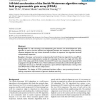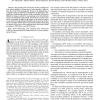64 search results - page 2 / 13 » Are Too Many Programmers Too Narrowly Trained |
EMNLP
2010
13 years 3 months ago
2010
Many sequence labeling tasks in NLP require solving a cascade of segmentation and tagging subtasks, such as Chinese POS tagging, named entity recognition, and so on. Traditional p...
BMCBI
2007
13 years 5 months ago
2007
Background: To infer homology and subsequently gene function, the Smith-Waterman (SW) algorithm is used to find the optimal local alignment between two sequences. When searching s...
MLMI
2004
Springer
13 years 10 months ago
2004
Springer
In this paper a system that transforms speech waveforms to animated faces are proposed. The system relies on continuous state space models to perform the mapping, this makes it po...
CSL
2010
Springer
13 years 5 months ago
2010
Springer
Recently, discriminative training (DT) methods have achieved tremendous progress in automatic speech recognition (ASR). In this survey article, all mainstream DT methods in speech...
ICRA
2003
IEEE
13 years 10 months ago
2003
IEEE
—The learning from observation (LFO) paradigm has been widely applied in various types of robot systems. It helps reduce the work of the programmer. However, the applications of ...


